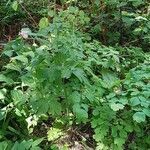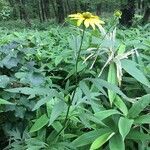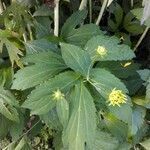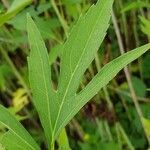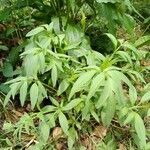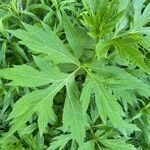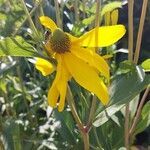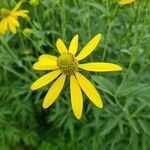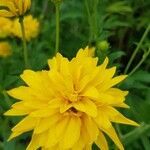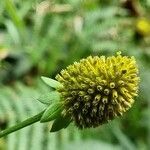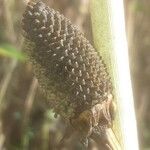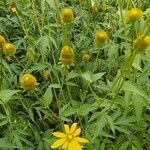Perennials, 50-200 cm tall. Leaves green; blade broadly ovate to lanceolate, all but distalmost ones 1-or 2-pinnatifid or pinnately compound; leaflets or lobes 3-11, glabrous or hairy, base cuneate to attenuate or cordate, margin entire or dentate, apex acute to acuminate; basal leaves petiolate, 15-50 × 10-25 cm; cauline leaves petiolate or sessile, mostly lobed to pinnatifid, sometimes not lobed, 8-40 × 3-20 cm. Capitula 2-25 in loose, corymbiform arrays; phyllaries 8-15, ovate to lanceolate, glabrous or hairy, margin mostly ciliate; receptacle hemispheric or ovoid to globose; paleae 3-7 mm, abaxially densely hairy at apex, apex truncate or rounded. Ray florets 8-12; corolla limb elliptic to oblanceolate, 15-50 × 4-14 mm, abaxially hairy. Disk 0.9-3 × 1-2.3 cm; disk florets numerous; corolla yellow to yellowish green, 3.5-5 mm; style branches 1-1.5 mm, apex acute to rounded. Achenes 3-4.5 mm; pappus coroniform or of 4 scales, to 1.5 mm. Fl. Jul-Sep.
Erect, rhizomatous perennial herb. Stems usually glabrous, sometimes sparsely clothed in short hairs, up to 2-(3) m tall. Lower and mid cauline lvs usually glabrous, sometimes moderately clothed in short hairs on lower surface and sparsely hairy on upper surface, petiolate, ovate-triangular, 2-pinnatisect, or 3-foliolate and leaflets 1-pinnatisect; segments ± entire to coarsely and irregularly serrate, (2)-4-16 cm long. Upper cauline lvs similar to lower but becoming shortly petiolate or apetiolate, smaller, and often 3-lobed or not lobed. Capitula c. 8-12 cm diam., in loose cymes. Involucral bracts in 1 row, glabrous, or ciliate to moderately hairy, narrow-lanceolate, subulate, or elliptic and narrowed to base, 8-20 × 3-5 mm. Receptacular scales membranous, with apices densely covered in short hairs. Ray florets 8-numerous, yellow; disc florets numerous, greenish yellow. Achenes brown, glabrous, 3.5-5 mm long; corona indistinct.
Perennial from a woody base, 5–30 cm; stem glabrous, often glaucous; lvs large, petiolate, coarsely toothed or laciniate, some or most of them pinnatifid or sometimes merely trilobed, subglabrous, or hairy beneath; disk yellow or grayish, 1–2 cm wide, hemispheric at first; rays drooping, lemon-yellow, 6–16, 3–6 cm; receptacular bracts blunt, distally viscidulous-canescent; pappus a short, usually toothed crown; 2n=36, 54, 72, 102+. Moist places; Que. to Fla., w. to Mont. and Ariz. July–Sept. Three vars. with us, a fourth cordilleran.
A daisy family plant. It grows 2-3 m high and spreads 0.9-2 m wide. It keeps growing from year to year. The leaves are deeply lobed or divided into leaflets along the stalk. They are blue-green and often hairy underneath. The flower heads are 12 cm wide. The flowers are yellow and yellow green in the centre.
